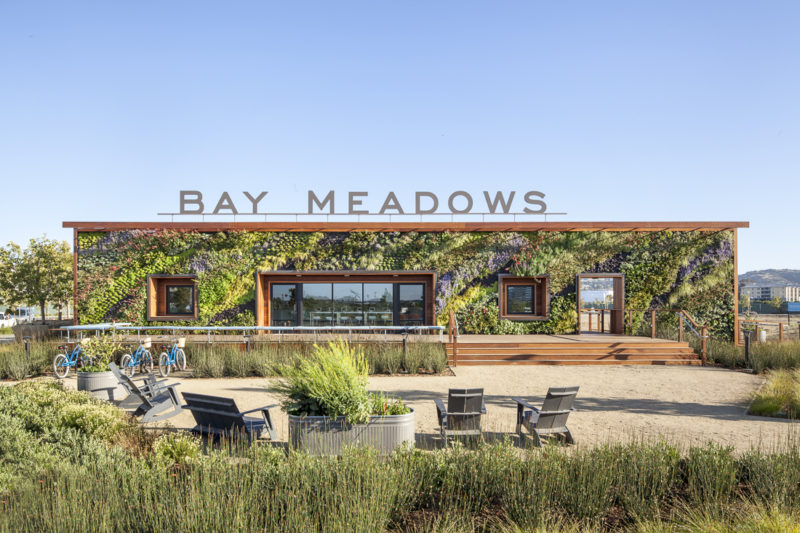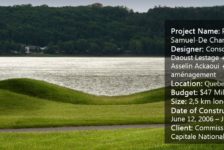Vertical gardens have recently become very trendy in the world of landscape architecture and design. There are many readily available vertical garden products and systems on the market, making them popular with the DIY community and also for corporate branding. This is the first in a 9 post series on vertical gardens, where I will be talking about different types of vertical gardens, their history, and some of the unique characteristics that have, and continue to make them unique and unexpected additions to the landscape.
A successful vertical garden is an assemblage of many different types of plants, suited to adapt to verticality, specific moisture conditions on the wall, solar exposure, wind exposure, and varying levels of disturbance. As such, it bears much similarity to the roof garden.
Vertical Gardens and Green Roofs. Image © Tamara Urben-Imbeault
While vertical gardening obviously includes a few challenges that differentiate it from roof gardening, overall the two are quite similar in the following aspects; micro-climate, limited soil, irrigation requirements, and plant pallet. But, before you go out and buy a roofing system to put on your wall, you should know that wall planting systems are very different from roofing systems, and it is critical that you choose one that is suited to your intended application. However, these similarities mean that many of the advantages of vertical gardening are similar to those of green roofs, namely:
– Aesthetic improvement,
– Reduction of the Urban Heat Island (UHI) Effect,
– Improvement of air quality through pollution and dust control, as well as carbon sequestration,
– Storm water absorption (if designed to receive storm water run off from a horizontal surface like a roof top),
– Noise reduction and refraction,
– Potential for native habitat integration,
– Potential for food production,
– Increased urban green space and improved livability (Biophilia),
– Corporate image greening,
– Local job creation,
– Use of under-utilized urban spaces (facades),
– Worth LEED points.
RELATED STORY: Top 5 Green Roofs from Switzerland Tour
There are two overriding categories that all vertical gardens can be classified into: soil bearing and non-soil bearing systems.
SOIL BEARING SYSTEMS
Soil bearing systems are very widespread. From vines planted in the ground to elevated planter boxes and even to planter-style retaining walls, there are lots of iterations of these available on the market today. Some of these systems require additional irrigation, while others can be designed without it, as long as growing conditions are favourable and manual watering is provided during the establishment phase of the plants.
Soil bearing designs are generally less expensive, but often much heavier than soil-free systems. Below is an example of a vine wall at the ARTLab at the University of Manitoba that grows up from soil in the ground, and around a metal trellis. The Virginia Creeper, Parthenocissus quinquefolia, here grows about 2 feet away from the building, leaving plenty of space for the vines to fill out over time. Planted only 2 short years ago, the vines remain quite small, but over time they will grow to cover the entire wall.
 ARTLab vertical trellis by Amico. Building by Patkau Architects, Image © Tamara Urben-Imbeault
ARTLab vertical trellis by Amico. Building by Patkau Architects, Image © Tamara Urben-Imbeault
 Aveda Green Wall. Image © Tamara Urben-Imbeault
Aveda Green Wall. Image © Tamara Urben-Imbeault
Not all soil bearing systems are quite so obviously soil bearing. Just last weekend, I stumbled upon a green wall (pictured above) in the Minneapolis International Airport. I had initially assumed that it wasn’t soil bearing (because of the density of plants), but upon further inspection I saw that it was. It was a relatively simple design; common potted plants arranged on a metal framework to hold them in a way that successfully hides all the pots and covers the whole wall. The beauty of this kind of garden is that any diseased or dead plants can very easily be removed and replaced, without the need for specialised maintenance crews.
RELATED STORY: Vertical Garden System at the Screen House | San Francisco, CA
The last, and least common, type of soil bearing vertical garden I will discuss in this article is the planted retaining wall. These walls are typically composed of modular concrete or masonry units that contain openings for plants on one side. These walls must be carefully designed by a landscape professional.
NON-SOIL BEARING SYSTEMS
Non-soil bearing systems are a bit more specialized and require a slightly more elaborate set up than soil bearing designs. These include hydroponic gardens, which utilize a felt-like material as the growing medium for the plants. These types of gardens require regular irrigation, and are always sold with automatic watering systems. Such systems also need nutrient mixes added to the water to ensure that the plants get the proper minerals they need to thrive. The most well known hydroponic vertical gardens are the work of famed Botanist Patrick Blanc. His trademarked design, the Mur Vegetal, has been installed in various locations around the world. The Caixa Forum (pictured below) is one of his most well known gardens.
 Caixa Forum Madrid. Image © Patrick Blanc
Caixa Forum Madrid. Image © Patrick Blanc
As beautiful and exciting as all of these projects are, there are a few drawbacks that designers face when planning a vertical garden. Even though vines have been growing on facades around the world for centuries, there are still many unknown factors and misconceptions about vertical gardens. The most common hurdles a designer can expect to face during a vertical garden project are;
– Lack of knowledge and awareness from the public and designers,
– Lack of empirical evidence of longevity, and ecological significance,
– Lack of detailed and large scale analysis of regional and neighbourhood scale impacts,
– Lack of climate specific precedents and tested/proven plant lists,
– High cost, and lack of government incentives,
– Lack of industry codes and standards,
– Associated risks such as structural damage due to water/plants.
There are currently researchers working to diminish the impact of the drawbacks listed, and depending on your climate and country, many of these may have already been overcome for you!
There are many different types of vertical gardens that range in complexity, from large scale commercial installations, to smaller DIY-style projects. Whether you are designing a landscape for a large corporate office, or something more modest for a backyard or balcony, there are lots of vertical gardening options out there! Have a look at the sources below for further information, and watch for the next post in our Vertical Gardening Series, entitled “Vertical Gardening Throughout the Ages”!
Lead image: Bay Meadows Welcome Center. Designed by BCV Architects. Living Wall Installation by Habitat Horticulture. Image © Gary Belinsky
Written by Tamara Urben-Imbeault, M.L.Arch. student at the University of Manitoba, Winnipeg, Manitoba, Canada.
She is currently working on her design thesis entitled “Vertical Gardening in Cold Weather Climates”
Contact: umurbeni[at]myumanitoba[dot]ca or t.urbendesign[at]gmail[dot]com or post a comment below!
Sources:
Bass B., Baskaran B. (2003) Evaluating Rooftop and Vertical Gardens as an Adaptation Strategy for Urban Areas, Institute for Research and Construction, NRCC-46737, Project number A020, CCAF Report B1046, Ottawa, Canada, National Research Council.
Blanc, Patrick. (2008) The Vertical Garden From Nature To The City. New York: W. W. Norton & Company Inc.
Dunnet, Nigel & Kingsbury, Noel. (2004) Planting Green Roofs and Living Walls. Portland: Timber Press Inc.
Green Roofs for Healthy Cities, GRHC (2010) Green Walls 101: Systems Overview and Design Second Edition Participant’s Manual. Green Roofs for Healthy Cities.
Peck SW, Callaghan C, Bass B, Kuhn ME (1999). Research Report: Greenbacks from Green Roofs: Forging a New Industry in Canada. Ottawa, Canada: Canadian Mortgage and Housing Corporation (CMHC).
Published in Blog











Tosh K
Two things I’ve noticed regarding ‘green facades’ for exterior applications:
1. For the cable/screen type, in many climates plants are hard to come by that are not invasive/aggressive (requiring maintenance not only on the facade but in areas around them and grow full to cover the armature).
2. The #1 limiting factor for ‘greenwalls’ -soil bearing systems- is cost (both upfront costs over $100/sf just for the armature and planting medium; and more importantly, maintenance -monthly at hundreds/month). The technical aspects are well studied and understood at least among the larger manufacturers and most architects/engineers.
Tamara Urben-Imbeault
Very good points Tosk K! As a Canadian living in Winnipeg, Manitoba (USDA Zone 2B) most of my research has been narrowly focused on more Northern climates, and in areas where vertical gardens aren’t well known or understood. But you are absolutely correct about invasive vines, and the costs of green walls. I am hoping that by increasing awareness about vertical gardens, that demand will increase, and the associated costs will decrease! Thanks for commenting!
Andrew Bolt
Tamara..here some pictures of the Bay Meadows HYDROPONIC Green Wall. I will let you draw your own conclusions on hydroponic systems
Tamara Urben-Imbeault
Thanks for the update Andrew!
It looks like the wall has definitely suffered a bit since the photo I used in my article was taken. I wonder if this is due to inconsistencies in the distribution of water through the wall? Perhaps it is a combination of irrigation issues and certain species maybe not adapting well to the verticality of the wall. The small purple plant (possibly a Heuchera?) for example seems to be in relatively good health, but is definitely not as robust as some of the other plants around it. I wonder if this could be because this plant doesn’t like to be vertical?
It seems you have formed your own opinion about this kind of vertical garden. I would love to hear it!
Thanks again for sharing your images and thoughts!!
sterlingsmith
Nice post on Vertical Gardens. You are absolutely true these types of gardens are very important in the landscape design. Few months ago I purchased a beautiful house in Temecula area and also I redesigned my house with the help of All In One Landscaper .They provided me quality landscaping services.